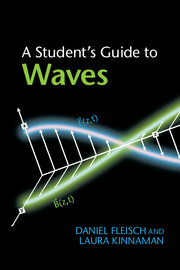2 - The wave equation
Published online by Cambridge University Press: 05 April 2015
Summary
There are many equations that describe wave behavior and the relationship between wave parameters, and you may well find such equations referred to as “the wave equation”. In this chapter, you can read about the most common form of the wave equation, which is a linear, second-order, homogeneous partial differential equation (the meaning of each of these adjectives is explained in Section 2.3 of this chapter). That equation relates the spatial (distance-based) variation of the wavefunction to the temporal (time-based) variation through the wave speed, as described in Section 2.2. Other partial differential equations that are related to the wave equation are discussed in Section 2.4.
If you hope to understand the wave equation (and all other partial differential equations), a good place to begin is to make sure you have a solid understanding of partial derivatives. To help with that, Section 2.1 provides a review of first- and second-order partial derivatives – if you're confident in your understanding of partial derivatives, you can skip that section and jump right into Section 2.2.
Partial derivatives
If you've taken any course in calculus or college-level physics, you almost certainly encountered ordinary derivatives when you learned how to find the slope of a line (m = dy/dx) or how to determine the speed of an object given its position as a function of time (vx = dx/dt). As you probably learned, there are many functions in mathematics and physics that depend on only one independent variable, and ordinary derivatives are all you'll ever need to analyze the changes in such functions.
But, as described in Section 1.6 of Chapter 1, wavefunctions (y) generally depend on two or more independent variables, such as distance (x) and time (t): y = f(x, t). Just as in the case of functions of a single variable, the process of differentiation is very useful in analyzing changes in functions of multiple variables.
- Type
- Chapter
- Information
- A Student's Guide to Waves , pp. 44 - 74Publisher: Cambridge University PressPrint publication year: 2015



